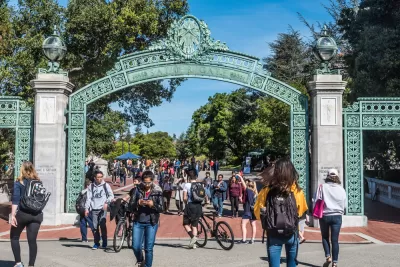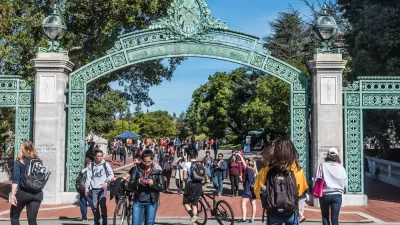A high-profile example of the power of the California Environmental Quality Act (CEQA) might cause thousands of students to miss out on a chance to attend the University of California, Berkeley.

"About 5,100 fewer high school seniors and transfer students will be offered a place at Cal for the next academic year because of an Alameda County Superior Court ruling that ordered UC Berkeley to freeze enrollment at the same level as 2020-21," reports Frances Dinkelspiel for Berkeleyside.
"The 24% drop in offer letters would bring about 6,450 new students to Cal — about 32% fewer than in a typical year," adds Dinkelspiel.
Planetizen picked up the news about the earlier enrollment freeze, also reported by Dinkenspiel for Berkleyside, in August 2021. Since then, the California First Court of Appeal turned down the university's request for a stay of the decision. Now the hopes for those 32 percent of students rests on the California Supreme Court—if the state's highest judicial body can even act in time for the March 23 date set for the university to mail its admission levels.
The controversy over the court ruling and its impact on enrollment at one of the top public universities in the world, hinges completely on planning--specifically the California Environmental Quality Act (CEQA), which requires environmental reviews of projects of certain size and potential impact, and also creates an effective form of local veto.
In this case, local neighborhood group Save Berkeley’s Neighborhoods used CEQA to sue the university on the grounds that the university should have prepared an environmental impact report for a plan to increase its enrollment by 2022-23.
"UC Berkeley did not do a separate EIR on the enrollment increase but instead examined it as part of an EIR for the Upper Hearst Development project, which will add a new building for the Goldman School of Public Policy and adjacent housing for about 225 people. UC Berkeley also focused in the EIR on the impacts of the increased enrollment to the main campus rather than the city," explains Dinkenspiel.
The August enrollment cap came along with a decision by Alameda County Judge Brad Seligman to toss the EIR for the Upper Hearst project.
Phil Bokovoy, the president of Save Berkeley’s Neighborhoods, seems unmoved by the potential of thousands of students losing access to the university. Bokovoy wrote in a court document that "Cal admits so many out-of-state students that it could reduce those numbers — and hold the number of graduate students to their 2019 numbers — and still admit all the California students who apply," according to Dinkenspiel's summary of the statement.
The news about the enrollment snafu was also picked up yesterday by Teresa Watanabe for the Los Angeles Times.
The news is the latest in a string of news about development opposition in California. Earlier this month, the city of Woodside declared itself mountain lion habitat in a failed attempt to avoid recent statewide zoning laws. A ballot initiative that would overturn those same state laws is also seeking signatures to qualify for a statewide vote.
FULL STORY: UC Berkeley must slash new enrollment by a third unless high court intervenes

Trump Administration Could Effectively End Housing Voucher Program
Federal officials are eyeing major cuts to the Section 8 program that helps millions of low-income households pay rent.

Planetizen Federal Action Tracker
A weekly monitor of how Trump’s orders and actions are impacting planners and planning in America.

The 120 Year Old Tiny Home Villages That Sheltered San Francisco’s Earthquake Refugees
More than a century ago, San Francisco mobilized to house thousands of residents displaced by the 1906 earthquake. Could their strategy offer a model for the present?

NYC Outdoor Dining Could Get a Re-Do
The city council is considering making the al fresco dining program year-round to address cost concerns from small businesses.

HSR Reaches Key Settlement in Northern California City
The state’s high-speed rail authority reached an agreement with Millbrae, a key city on the train’s proposed route to San Francisco.

Washington State Legislature Passes Parking Reform Bill
A bill that would limit parking requirements for new developments is headed to the governor’s desk.
Urban Design for Planners 1: Software Tools
This six-course series explores essential urban design concepts using open source software and equips planners with the tools they need to participate fully in the urban design process.
Planning for Universal Design
Learn the tools for implementing Universal Design in planning regulations.
Ada County Highway District
Clanton & Associates, Inc.
Jessamine County Fiscal Court
Institute for Housing and Urban Development Studies (IHS)
City of Grandview
Harvard GSD Executive Education
Toledo-Lucas County Plan Commissions
Salt Lake City
NYU Wagner Graduate School of Public Service





























